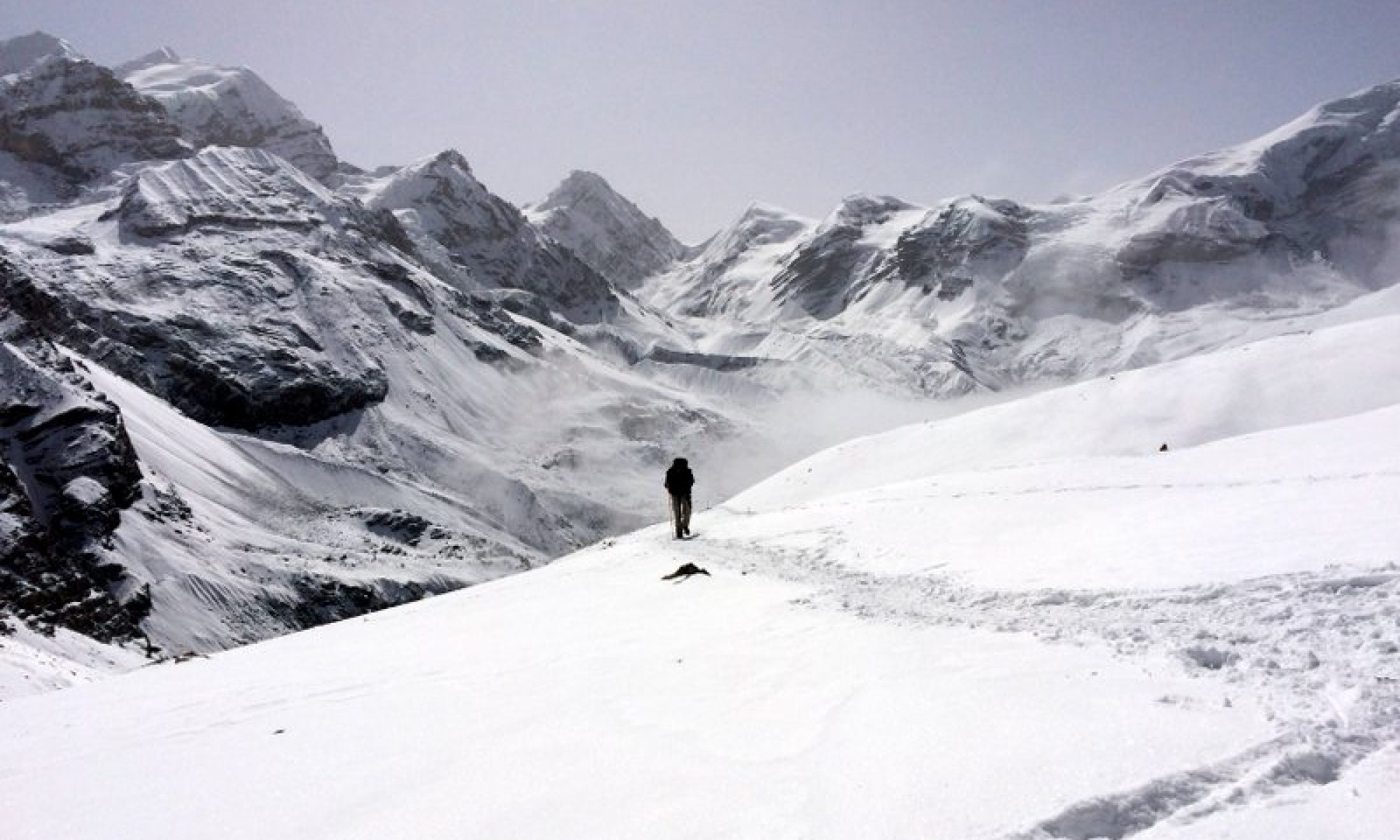We arrived in Nepal at the beginning of May 2018. After making only a few preparations in Kathmandu (such as buying appropriately warm clothes) we headed to the Annapurna region to fulfill a longtime bucket list adventure: The Annapurna Circuit Trek.
Being considered as one of the best and cheapest (!) treks in the world, we kept this trek on our wishlist ever since experiencing Nepal for the first time. Spoiler upfront: We were not disappointed.
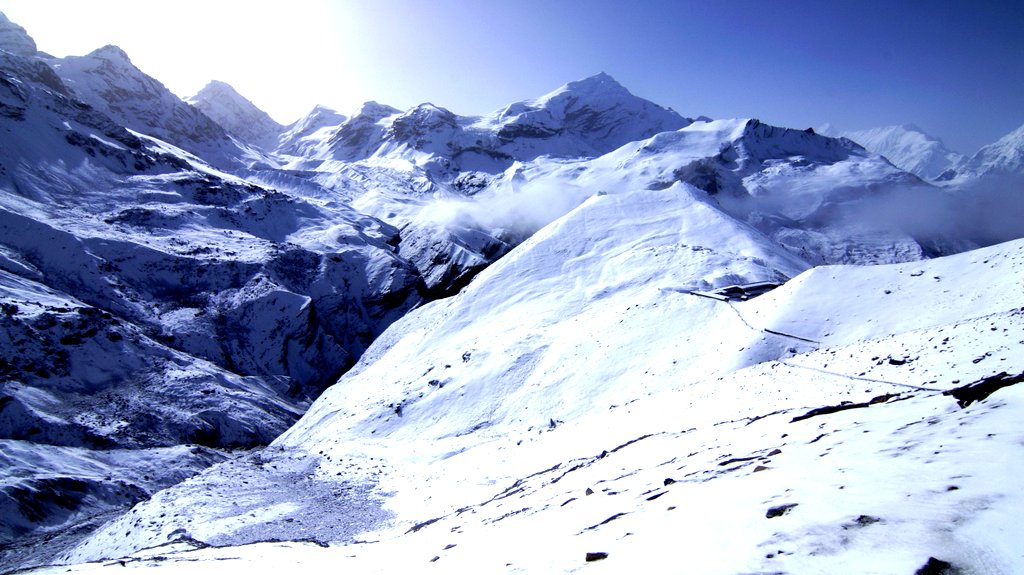
In this blog post we summarise our experiences on the Annapurna Circuit trek along with likes and dislikes. Of course there are also our lessons learned towards the end in case you want to tackle this trek yourself in the near future.
Our trek started on May 4th 2018, for us the perfect time. May was already the end of peak season for the Annapurna Circuit which meant less trekkers. The downside: Unstable weather and at lower elevations it was already really warm, but hey, at upper elevations it was warmer too. It was a bit of a gamble with the weather but we got lucky and had only one day of rain during the trek and three days of snow during the entire trek of 17 days. The rest of the time the weather was fine and we had clear skies for great views of the Annapurna & Co.
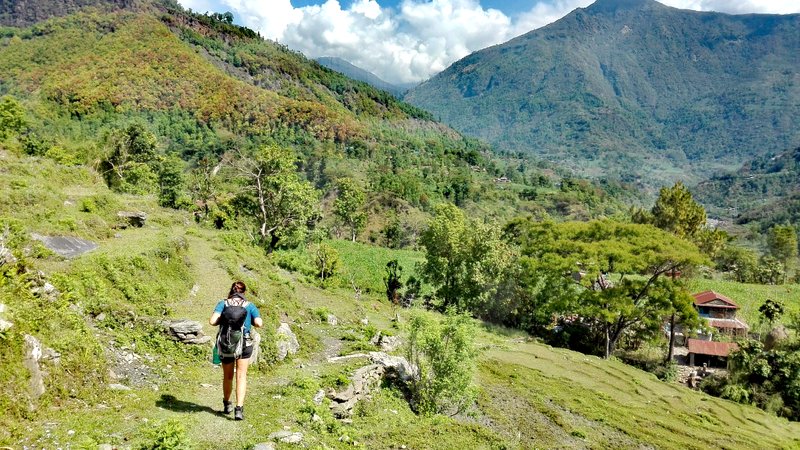
The very first days we pushed it a bit too hard. After trekking for 8 hours we reached a cozy homestay. The owner explained that there were natural hot springs just a few minutes down the valley. it turned out to be a walk of 45 minutes each way. Still the hot springs were worth it. The next day we covered a rather long distance again. These long days drained quiet some energy and we got more tired day by day. After the first three to four days we drastically reduced the daily walking time to five to six hours. It’s holiday after all.
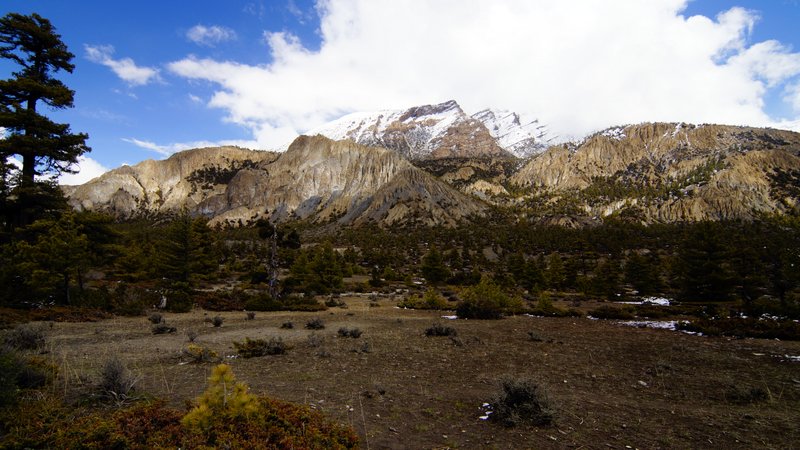
It took us eight days to reach Manang, a trekkers hub, well worth the visit. Most of the villages that you trek through are connected via road. Apart from some peak times there was not much traffic. One can always chose to walk through little trekking paths away from the road (the actual trek). In Manang this road ends, making Manang kind of a mile stone. Here we spent two days for acclimatisation and doing day hikes. We also caught colds on the trek and could recover in Manang from them before we went further up to less pleasant elevations.
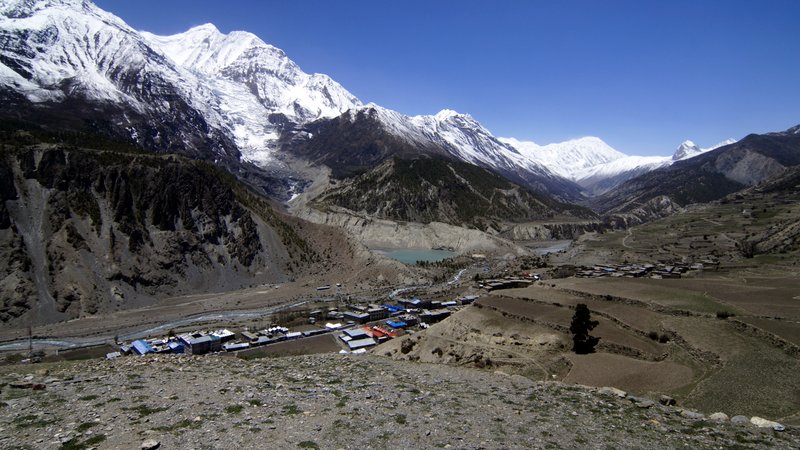
Interesting side trek experience: We trekked up to an ice lake situated at 4400m. On the way back down we passed through a tent village with about 30 tents just set-up on a plateau. It was at an elevation of around 4000 m. At first we thought these were mountaineers but there was no big mountain close by to justify this massive gathering. Our second thought was that it was home to people who lost their actual homes during the earthquake of 2015. Both wrong.
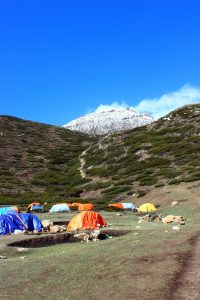
We learned the truth another 500 meters further down in a little tea house run by a local guy. Apart from us there were three locals eating and smoking charas. Something you see everywhere in Nepal. But what caught our attention was a little bag with about 500 grams of something that looked like dry pepperoni.
These men were merchants for the by far most expensive fungus that exists in the world: Caterpillar fungus (Cordyceps). It is used in traditional chinese medicine. Only growing at elevations above 4000m, it is a rare and hard to find commodity. The prices paid for this little fungus are huuuuge! The tent village was used by people who had their homes down in the valley but left home during the fungus season to search for it. Crazy!
After proper acclimatization in Manang our trek continued. We approached the Base Camp at 4400 meters for the pass crossing. Here were only stones and mountains and stones rolling down the mountains and snowfall. Not really cozy at all and we were glad when we made it to the shelter of the Base Camp.
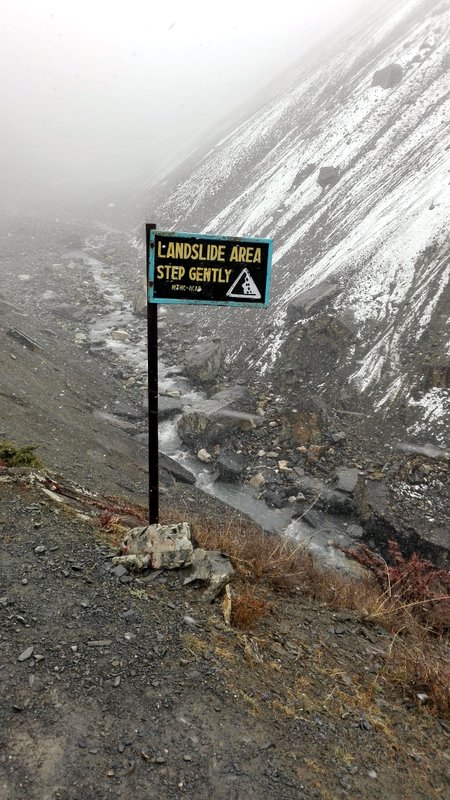
The common rooms always had enough people and an oven to warm the place. But the sleeping rooms were cold! The basic rooms offered only a bit of shelter and warmth from the cold conditions. The temperature was around -5° to -10° that night. We tried to sleep in our complete trekking gear (just without the shoes). Although this was warm enough we still had to get up at night to pee all the time. Apparently frequent urination is common at high elevations. Aaaand we were worried about the day to come: The plan was to get up at 5:00am and ascend by 1000 meters through snow to the pass. Only with thin air to breath.
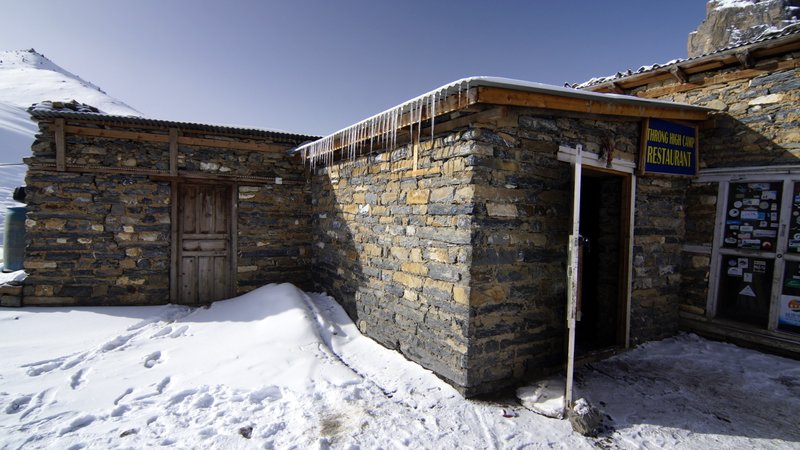
That was exactly what we did the next morning. Luckily the weather was on our side. The heavy snowfall from the day before was over and there was a clear blue sky waiting for us. Still it was hard! We teamed up with some other trekkers for company and moral on this hard day and left the lodge. On the way to the top we had to take about 8 breaks. When we were walking we just could do baby steps in order to keep our normal breathing rate. At one point there were just stones continuously rolling down on the trekking path from the mountains directly above us. It was scary because we were carefully walking along a steep and narrow cliff path while looking up to make sure a rock wouldn’t hit us and all of this while battling an uphill high-altitude trek. Like a real life jump and run. Everyone got through 🙂
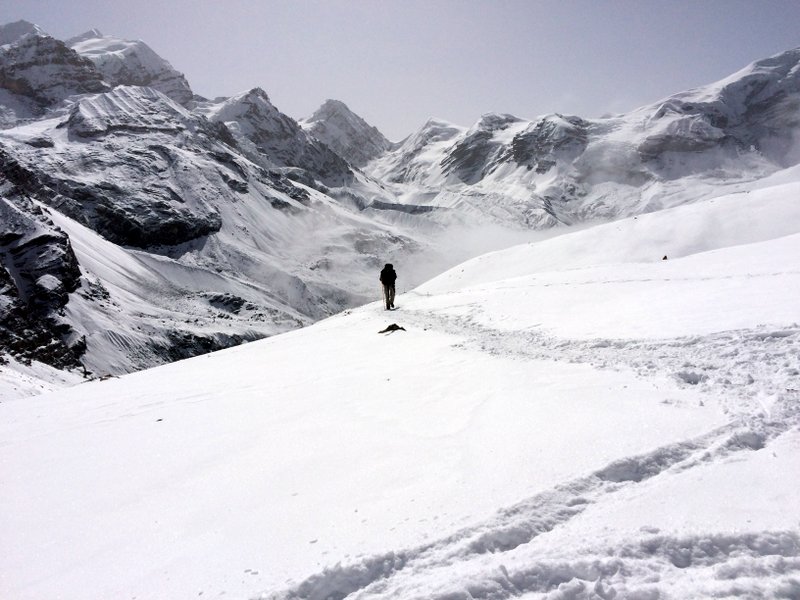
After an epic struggle through some of the most breathtaking scenery I have ever encountered we made it to the top at 5412m. That was day 12 of our trek. We barely made it to the top. But we made it. Thorung-La Pass check! We were sooo happy.
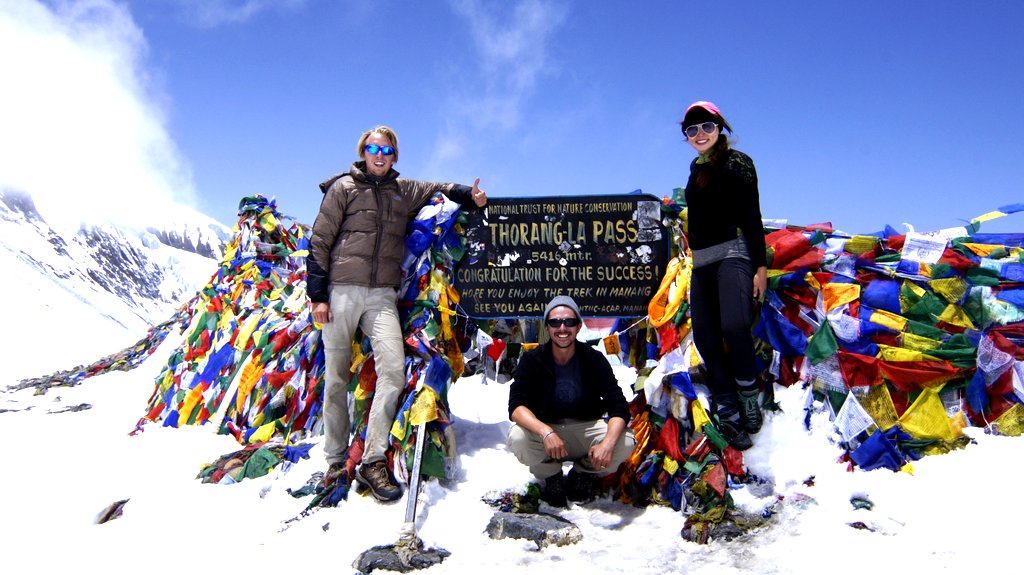
The trek was not over yet but the hard part was finished. We trekked 1200m down from the pass and reached the first villages in the region of Mustang towards the afternoon.
Here the happening place was the Bob Marley guesthouse. I kinda hate myself for giving into this mainstream telling name operation, but it was great. Full of other euphoria loaded travellers, who crossed the Thorung-La pass that day and with affordable (beer) prices again and with a vast food selection it was a party place.
We continued the next day to discover some stone villages in Mustang. Here the climate was severe. Picture a high plateau with little vegetation, rather a stone desert, little to no rainfall, clear blue skies and super strong winds picking up in the afternoon. Like a different planet. Definitely worth seeing. Here the trek also led us through river beds which was new for us. Still the winds were really strong and turned out to be quiet a pain in the ass. After leaving Mustang and after 17 days of trekking we decided to end the trek.

Two guys Ankit and Akrosh who were on a bike trip through Nepal picked us up and gave us a ride back down to Pokhara. That was ou circuit story.
The highlights
The Thorung -La Pass. That was a challenge!
The super diverse scenery. During the 17 days of the circuit we felt like we walked through all climates and landscapes: the low elevations were covered in dense, lush green jungle. Every day we were soaring a little higher and the vegetation changed. After a couple of days it was pine trees and even later huge green fields until we got to the top with paths covered in snow. After the pass we descended to Mustang. Here we were trekking through vast stone deserts and with winds so strong we literally had difficulties walking. Plus at almost every moment of the trek you have the wonderful view of some 7000+ high snow peaks.
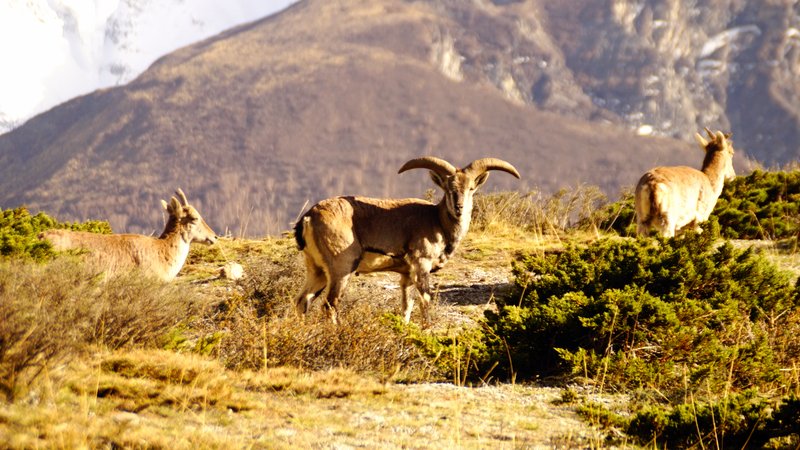
We passed by many villages with hot springs during the trek. It was always a nice treat after a long day of trekking.
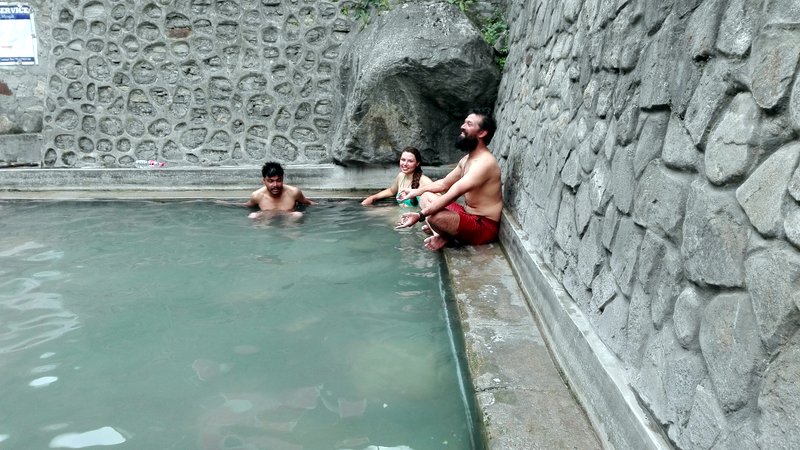
During the trek we met a lot of interesting people from Nepal and from all around the world. Great for evening talks around the burning stoves in tea houses.

The amount of other trekkers in May was also just right: Not too few, not too many. It was just the right amount of other trekkers. We were happy to encounter and engage in conversations with everyone we met. With more trekkers it would have been the anonymity on the trek as we know it from cities. This overload only happened in Manang, a village used by many trekkers for acclimatisation and side treks.
No up and down! We did the Annapurna Base Camp Trek in 2014 which is a beautiful trek but takes you quite often up and then back down and then up again. That is a bit demotivating. This does not happen too often on the Annapurna Circuit trek. It is rather a constant up. You earn your elevation and you can keep it, great!
The village Kagbeni aka the gateway to Upper Mustang was quite a hit. The scenery was not from this world and the village was made of these massive stones that sheltered it from the winds in the region. Worth a visit for sure.
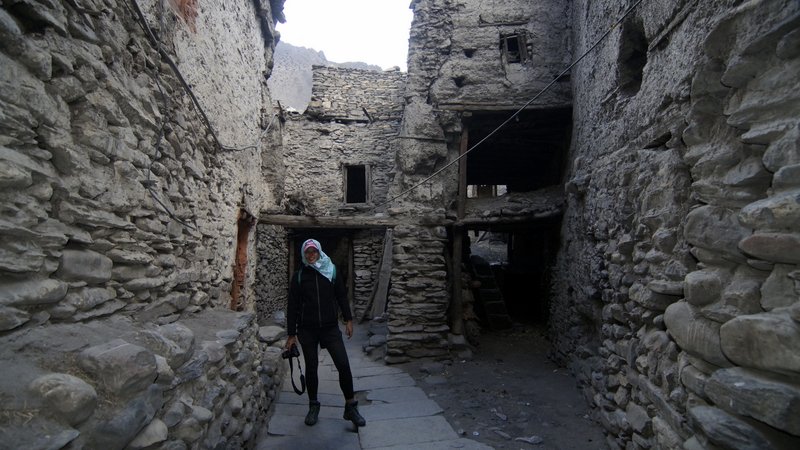
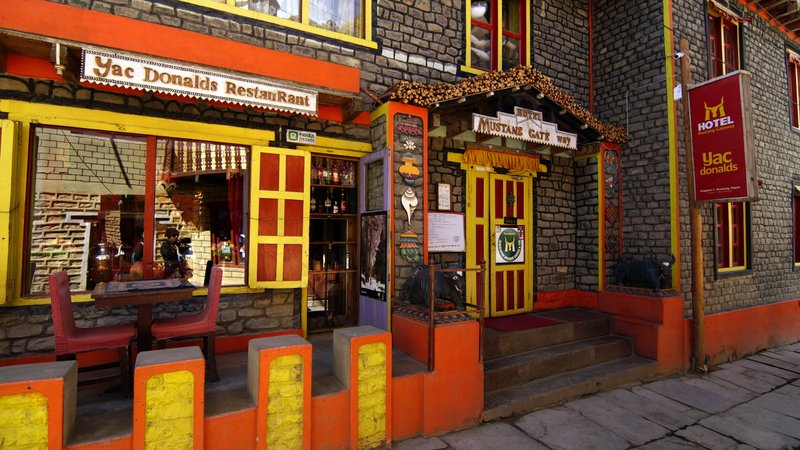
What might be a disadvantage
Unfortunately the trek got into missfortune in many reviews due to road constructions in some parts. Very few parts of the official marked trek require that trekkers walk along the road. We also skipped the road most of the time to take the actual trekking paths. Some parts of the road we did not skip and especially after Jomson encountered alot of traffic.
Another criticism we found while researching for the trek: Crowds of trekkers. That was simply not the case while we were there: May. But for those seeking a remote adventure this world famous trek is definitely the wrong choice.
Lessons learned:
If you consider doing the Annapurna Circuit yourself the info below will help you plan and get the most out of your experience.
How much to budget for the Annapurna Circuit
We spent on average 4000 NPR/ day for both of us. That includes also some treats and a diverse diet, not only dal bhat. Most of the time we did not have to pay for the accommodation but we did have to eat there.The largest cost drivers for us were teapots.
The higher you ascend the pricier it gets. Manang was also expensive (about 5000 NPR per day) but rather because we got tempted by the nice treats like cakes from the german bakeries.
Getting from Kathmandu to Besisahar, where the trek starts, was not expensive either.
The TIMS card and the Annapurna permit which are both mandatory and need to be acquired prior to the trek were 44 USD per person (!).
Despite these things it can be a very cheap trek.
Consider that most other treks require you to be accompanied by a guide.
Do I need a guide for the Annapurna Circuit trek?
No. It is up to you if you prefer the company of a local who can actually explain stuff to you. It is not mandatory and you should not get lost on the trek since it is marked very well.
We met some guides which were amazing: funny, entertaining, informative, and and and. We also met some who were rather following their own agenda reducing the flexibility of their clients.
Do I need trekking poles for the Annapurna Circuit?
Trekking poles?! Hell, yeah! Definitely recommendable. I mean, one can manage without. They increase stability and your comfort on the trek. We used ours just in the high elevations and to reduce the burden on the knees when walking down.
More Lessons Learned
The weather was not stable. Typically, the day would start off chilly and quickly progress into hot summer temperatures. The afternoons sometimes brought summer rain or in upper elevations snow and in the evenings the coldness made a return. Always having your sunscreen, winter gloves and rain poncho at hand could become a bit stressful.
Falling rocks. Look up when walking through landslide zones!
Hot springs. There are a lot of them and they are not always marked. Ask locals where the best spots are. Most hot springs contained large pools of warm water that one could bathe in, while others were a trickle of warm water, not much different than the water stream which comes out of your kitchen tap.
In the post below you’ll find a selection of pictures from the trek.
